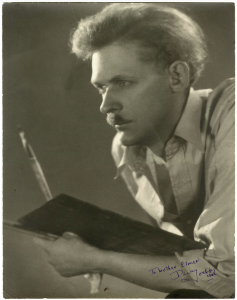

Biography
The child of middle-class Swedish immigrants in Minneapolis, Dewey Albinson was introduced to sketching and painting following a childhood accident, when his bicycle was stolen and he was shot in the leg. This was at age 12, and while he recuperated from his injury, solicitous neighbors supplied him with art materials and encouraged his obvious talent. More serious instruction followed at the Minneapolis School of Art (1919) and the Art Students League in New York. He studied with cubist masters in Paris from 1923-1925 and spent time in Italy at the end of that decade.An influence even stronger than his formal instruction was his involvement with nature. From an early age he would venture into the wilderness areas of Minnesota, particularly along the shores of Lake Superior. In 1922 he visited what is now part of the Grand Portage National Monument and developed a life-long interest in the indigenous cultures of that region. During that visit he painted an important cultural artifact of the Ojibwe people, the Spirit Little Cedar Tree. His painting was printed in the Minneapolis newspapers with the popular title "The Witch Tree," gaining him considerable renown. His explorations of the region gained him an invitation to conduct an archeological survey for the Minnesota Historical Society. This work was an initial step to preserve this area from development and was an important factor in the eventual designation of the region as a National Monument.
Throughout the 1920s and 1930s Albinson traveled across Minnesota and painted its towns and its areas of natural beauty. He received commissions from mining companies and railroads to depict their activities, even as he railed against industrial development that would despoil natural areas. He was named head of the painting department at the St. Paul School of Art from 1926-1929. And, following his sojourn in Italy, he became the Project Director for the Minnesota State Department of Education. This work involved funding projects statewide, including ones that reached various Indian reservations. He was particularly interested in this work, although frustrated by the fact that the funding he could supply was woefully inadequate for the needs he was trying to address. (His own salary amounted to something like 75 cents an hour!)
Burnt out by this experience and lacking the time to paint while he worked as an administrator, he moved first to Quebec and then to New Jersey. He split his time between New Jersey and Mexico for awhile, before moving permanently to Mexico in the 1940s. His renown as an artist had probably peaked in the mid 1930s, although he continued to paint for decades. He spent over a dozen years in Mexico working on paintings relating to Cervantes's Don Quixote, the images being a major departure from his earlier work, in which - aside from the portraits he made - human figures were largely absent.


Critical Analysis
Albinson's palette was characterized by art tones and pastels, and he used it to capture a haunting beauty in his Minnesota scenes. He approaches his canvases with strong, expressionist brushstrokes. His studies in Paris had a major influence on his style. While he wasn't exactly a cubist painter, he did provide strong emphasis to the geometric elements of his compositions. His work is well-represented in museums across the country. Critics complained - with some justification - that his fundamental approach to painting did not evolve over time, but his works of the 1920s and 1930s remain powerful and beautiful.Murals
- Marquette, Michigan - U.S. Post Office and Federal Courthouse: Marquette Exploring Shores of Lake Superior
- Cloquet, Minnesota - Post Office: Lake Superior Shores - Yesterday and Today
References
- Art by Dewey Albinson (Art by Dewey Albinson).
- Cori Sherman North, Donald Myers, Art for All: The Swedish Experience in Mid-America, Hillstrom Museum of Art August 25 - October 20 (2019). Brochure for a show at the Hillstrom Museum of Art
- Mary Towley Swanson, The Artist as Chronicler, Minnesota History Fall (1991).
- William J. Wittenbreer, The Development of An Artist's Paradise: Minnesota Landscapes: 1840-1940 (2004).
- Dewey Albinson (Wikipedia).
- Dewey Albinson (1898-1971) (Hiro Fine Art).
- Carolyn Gilman, The Grand Portage Story. Minnesota Historical Society Press , St. Paul (1992). Online at the National Park Service. Chapter 6: The Boundary of Cultures describes Albinson's involvement with this region.
- Oral history interview with Dewey Albinson, 1965 October 27 (Archives of American Art).
- Swedish-American Works from the Hillstrom Collection (Hillstrom Museum of Art).